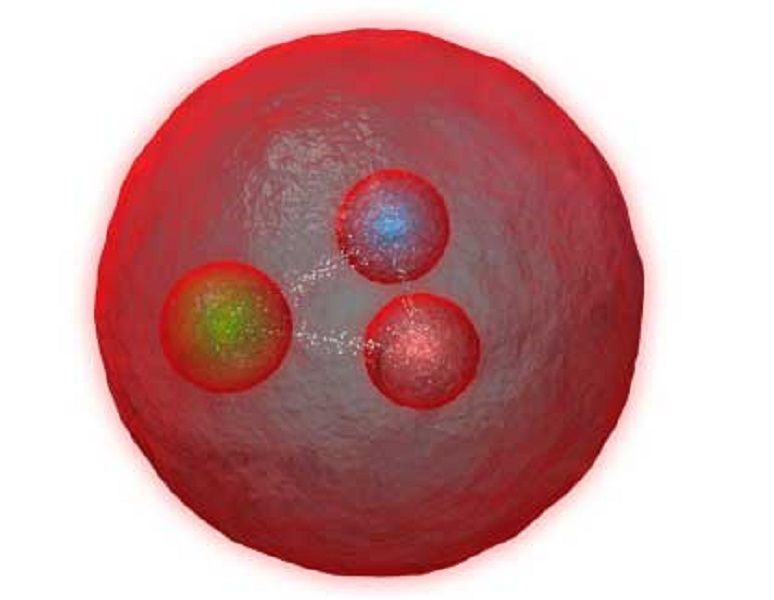
A new type of particle has been discovered by scientists at CERN using data from last year's run of the Large Hadron Collider (LHC). The particle opens the door to a "new frontier" of physics, providing researchers with a new way to investigate the fundamental forces of the universe that make up the Standard Model of particle physics.
Xi-cc++ is a "doubly charmed baryon," a family of heavy quark particles predicted by the Standard Model, but evidence of which has never before been found. The Standard Model, at present, is the primary theory for explaining how the basic building blocks of matter interact as per the four fundamental forces—gravity, electromagnetism, weak interaction and strong interaction.
But the Standard Model is incomplete. While it explains much of what we see in the universe, it only incorporates three of the four forces, leaving out gravity. It also does not answer fundamental questions, like what dark matter is and what happened to antimatter after the Big Bang.
The new particle goes helps support the Standard Model and will allow scientists to carry out new experiments to better understand how the universe works.
Giovanni Passaleva, spokesperson of the LHCb collaboration, said: "Finding a new heavy-quark baryon is of great interest as it will provide a unique tool to further probe quantum chromodynamics, the theory that describes the strong interaction, one of the four fundamental forces. Such particles will thus help us improve the predictive power of our theories."
What is the new particle?
The vast majority of matter that surrounds us is made of baryons which are composed of three quarks. The most common types of baryon are protons and neutrons, which are made up of light up and down quarks.
There are six types of quarks and scientists predict there are many different combinations that can make up baryons. Until now the only baryons observed contain two light quarks and one heavy quark.
While physicists predict (as per the Standard Model) there should be baryons with two heavy "charm" quarks, until now their existence had never been confirmed. The discovery of Xi-cc++ shows "doubly charmed baryons" do indeed exist.
Researchers at CERN used data from the LHC beauty (LHCb) experiment, which looks to work out what happened just after the Big Bang that allowed matter to survive and become the universe we see today.
The LHCb data was collected in 2016 during the last run of the LHC. In it they found over 300 of the new Xi-cc++ particles, vastly more than the last time scientists believed they had found hints of doubly charmed baryons.
Fermilab SELEX experiments appeared to have found a new particle Xi-cc+ over a decade ago, but follow-up experiments failed to find it. It also caused problems for physicists studying it. "The properties measured by SELEX of the state that they observed were inconsistent with those predicted by theoretical calculations, and so the claim by SELEX has remained controversial and awaiting confirmation by another experiment," Patrick Spradlin, one of the scientists who led the LHCb experiments, tells Newsweek.
Unlike this particle, Xi-cc++ does not deviate from the Standard Model, and researchers found far more of them. "SELEX's claim was based on a very small number of observed interactions, approximately 16, that only just cleared the threshold for a statistically significant observation," he says. "We have seen 313 interactions in data collected in 2016 and 113 interactions in data collected in 2012. Our observation has a [high] statistical significance...and is unambiguously real."
Scientists found Xi-cc++ by looking at the trail of particles it would normally decay to, then tracing that back. The high collision energy of the 2016 dataset meant the team was able to find traces of Xi-cc++ far more easily. They were able to find over 300 Xi-cc++ particles and researchers showed they behaved just as the Standard Model predicts they should. The new particle is heavy, with a mass around 3.5 times heavier than protons and neutrons, and has double the electric charge of a proton.
Paul Soler, Professor in Experimental Particle Physics at the University of Glasgow, said in a statement: "This is the first time that a baryon has been conclusively observed containing two heavy charm quarks and is a new frontier in understanding the strong force that binds quarks together."
Uncommon Knowledge
Newsweek is committed to challenging conventional wisdom and finding connections in the search for common ground.
Newsweek is committed to challenging conventional wisdom and finding connections in the search for common ground.
About the writer
Hannah Osborne is Nesweek's Science Editor, based in London, UK. Hannah joined Newsweek in 2017 from IBTimes UK. She is ... Read more
To read how Newsweek uses AI as a newsroom tool, Click here.








